Tips for Picking the Best Sleeping Bag for Winter Camping
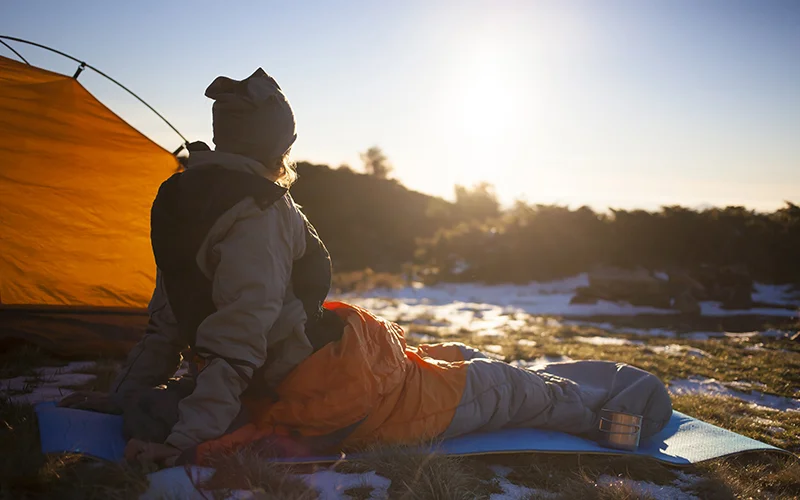
How to Choose the Best Winter Sleeping Bags for Your Outdoor Adventures
Rain or shine, sleeping bags are there to keep you warm and dry but what are the features to look for in the best sleeping bag for cold weather?
In addition to information about the characteristics of the best cold weather sleeping bags, you’ll gain from this article a better understanding of sleeping bag construction and insulation. You may find the materials to be different than those of regular sleeping bags.
In addition, you’ll learn about sleeping bag shapes and temperature and season ratings.
Let’s start with the anatomy of winter sleeping bags, shall we?
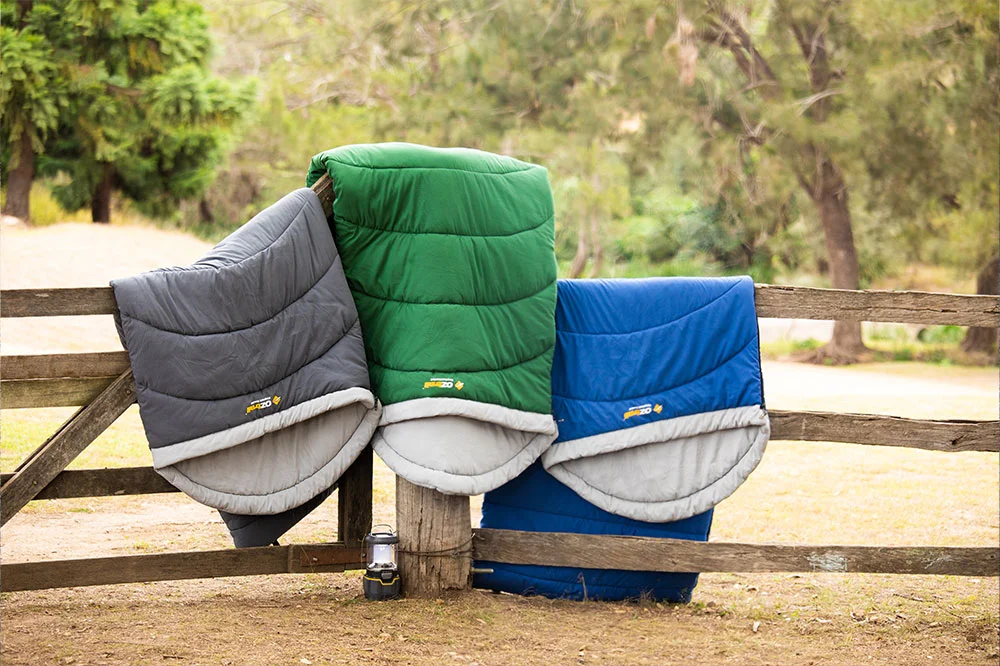
The Anatomy of Winter Sleeping Bags
The following parts work together to shield your body from the cold.
Shell
This is the outer section that keeps moisture and wind away. The shell also houses the insulation.
Hood
Without the hood, there is no way to keep warm in freezing temperatures. It’s best to go for a hood that’s properly equipped with Velcro and easily accessible cinch cords.
Footbox
Find a sleeping bag that has a shaped footbox with side walls. This way you’ll have enough leg room. Plus, there won’t be any cold spots because your feet don’t press up against the insulation.
Draft Collar
The draft collar is an insulation-filled flap or tube. It’s at the neck opening and the purpose is to prevent heat and draft from coming in. This feature is crucial if you want a sleeping bag that works at -6°C or lower.
Instead of a draft collar, some of the best sleeping bags for cold weather have a yoke. This is an insulated tube which dangles at the neck and keeps the draft out.
Insulated Draft Tube
Some models may even have a couple of these tubes. They sit behind the zipper to keep out air that may penetrate the coils.
Zipper
As a key design element, the sleeping bag zipper is there to provide a secure closure and keep the elements at bay.
You should be able to operate the zipper smoothly and you might want to consider a sleeping bag that sports a stiffened backing to prevent the zipper from snagging.
A centred zipper is another thing to look for. This position allows you to sit up in the sleeping bag and perform simple chores. Plus, sleeping bags with a centred zipper tend to be more lightweight.
Tip: If you get a sleeping bag with a shorter zipper that doesn’t run all the way, make sure it has foot vents.
Pad Straps
These may come in the form of sleeves. They are at the sleeping bag’s underside to keep the bag firmly on the sleeping pad.
Baffles
Baffles are the inside chambers that secure the insulation. With these, the insulation won’t bunch up or shift.
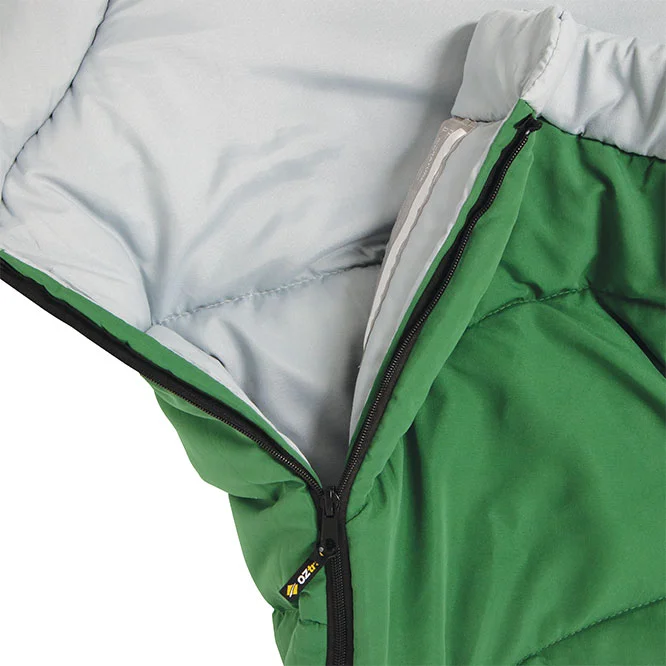
Insulation Essentials
Needless to say, the fill or insulation can make or break your sleeping bag. The more insulation there is, the warmer the bag becomes. But it’s not only about the thickness.
The insulation type may have just as much to do with it. The first decision you’ll need to make is to decide between synthetic and down. Let’s take a closer look.
Synthetic Insulation
If you are looking for the best sleeping bag for cold and wet conditions with an eye on the price, synthetic insulation is a good choice.
The most common is water-resistant fluffy polyester, the same fill material found in pillows. As mentioned, synthetic sleeping bags are budget-friendly and they are good up to medium-cold weather conditions.
On the other hand, these bags tend to be quite bulky and heavier than down sleeping bag. Something to consider if your camping trip includes long hikes.
Goose Down Bags
Any way you look at it, natural goose down outperforms synthetic winter sleeping bags, assuming price is not a concern.
Ask any experienced campers about the best sleeping bag for extreme cold weather and chances are it will feature down insulation. Besides the superior insulation, this material is also lightweight – hey, a goose needs it to be lightweight to float. Plus, you won’t have any problems compressing a down sleeping bag.
Compared to synthetics, down keeps its loft for much longer. This gives you an extended insulating power for extreme weather conditions. As you might guess, down sleeping bags can be significantly more expensive.
For the most part, the greater the fill power the more you need to pay. The fill power is a quality rating that measures the expansion or loft volume of one ounce of goose down in cubic inches. The typical fill power range is 600 to 900. Obviously, the higher rating means loftier insulation and more warmth.
Note: It might also interest you to look for a global Traceable Down Standard (TDS) or Responsible Down Standards (RDS) on any goose down products. That’s if you care about the treatment of geese and duck where the down comes from.
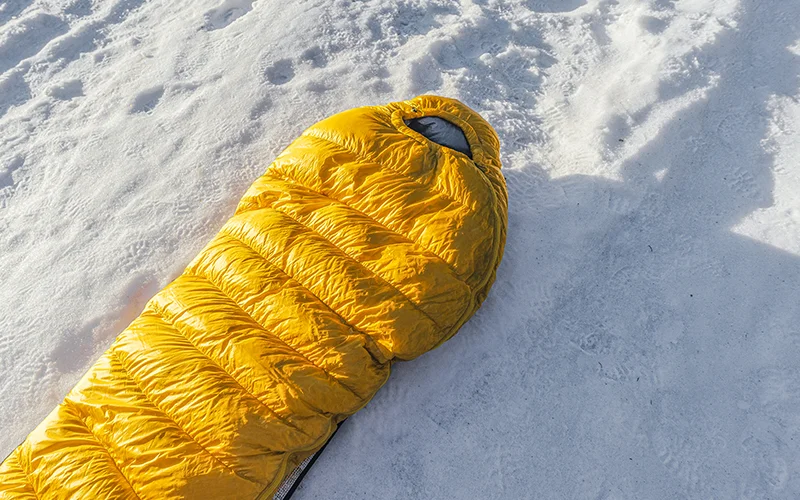
Best Cold Sleeping Bag - Shapes
Winter sleeping bags come in a number of shapes.
Rectangular
Rectangular sleeping bags don’t feature a taper at the legs. As such, they won’t keep you warm in colder weather.
These bags are suitable for moderate weather, sleepovers, and backyard camping. That said, you might get away with using a rectangular sleeping bag inside a double-wall tent.
Mummy
This is the shape to go for if you want the best sleeping bag for winter camping.
Besides the tell-tale mummy head closure, these bags are gradually tapered at the legs to keep the cold out and the body heat in.
Mummy bags require less insulation and material. Therefore, they are smaller but not necessarily lighter. For example, a very thick mummy sleeping bag is going to be heavier than most rectangular sleeping bags.
As you might imagine, mummy bags will take a bit of getting used to. If you are claustrophobic or a restless sleeper, you might want to try out a different shape. This might also be true for those with broad shoulders.
Semi-rectangular
Semi-rectangular sleeping bags are somewhere between rectangular and mummy. Campers who feel uneasy inside a mummy bag might appreciate the extra room.
These bags are also warmer than the straight rectangular type. By extension, they tend to be bulkier than mummy sleeping bags.
There are a few different shapes of semi-rectangular bags. And some campers refer to them as barrel or modified mummy. Overall, these bags offer a good balance between comfort and warmth.
Double Bags
If you go winter camping with your family, double sleeping bags are a good option. They are rectangular so you’ll have to pay attention to the insulation. In any event, with two persons inside the bag, that’s going to provide extra warmth.
Construction
This is yet another element that affects sleeping bag performance and warmth. These different constructions help keep the insulation in place.
Box Wall
Just like down comforters, down sleeping bags usually have boxed walls. There is a vertical wall between the inside liner and the shell. It keeps the down inside a box as the material is notorious for shifting. With these boxes, you localise the shifting.
The boxes come in various shapes. They can be trapezoidal, slanted, or just plain rectangular boxes. Trapezoidal is common in down sleeping bags to trap the insulation fills in the corners and prevent heat loss.
Should you need the best cold weather hiking sleeping bag, it’s best to go for a down sleeping bag with box walls.
Stitch Through
In this design, the inside liner and shell feature stitching that holds the insulation in place.
This construction is quite common but it may not be suitable for winter camping. Stitch-through sleeping bags can have cold spots and heat may escape through the seams.
Welded
Welding is a better construction than stitch through as there are no seams or pinching. Welded sleeping bags are warm, lightweight, and highly compressible.
They are also good at keeping heat in. Like stitch though and shingle, this is a feature of synthetic sleeping bags.
Shingle
In the shingle construction, the insulation sheets overlap and stitch to the lining and shell. This is better at keeping the insulation in place and preventing heat loss and cold spots.
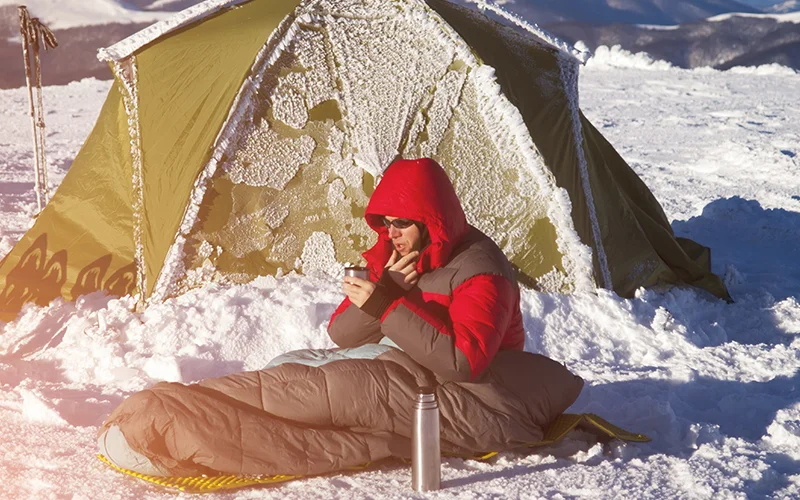
Temperature Ratings
Manufacturers utilize the EN 13537 test to come up with temperature ratings. You can use the rating to determine if the bag is suitable for cold or winter conditions.
As a standard, the test assumes a fully dressed camper who isn’t hungry or thirsty. You might find the temperature icon on the sleeping bag’s feature tab. There are three ratings.
Comfort Temp
This indicates the temperature that ensures the average adult woman can have a comfortable sleep.
Limit Temp
The average adult male should be able to sleep comfortably sleep at this temperature, assuming he is in a curled position.
Extreme Temp
This number shows the minimum survival temperature for the average woman. The person might survive but there’s a higher risk of frostbites and hypothermia.
Season Rating
When looking for the best-rated cold weather sleeping bags, you have to pay attention to the season rating as well.4-season means all year round, but a 3-season sleeping bag might work at the end of winter if the conditions are not too harsh. Here’s a list of season ratings to look for in winter sleeping bags:
3+ season
Under extreme winter conditions, these sleeping bags work well for camping off the mountain. They work for different outdoor needs, such as climbing, hiking, and adventure trips. Plus, 3+ season sleeping bags are better for the rest of the year.
4 season
Sleeping bags rated 4-season feature premium materials, insulation, and construction. Each component is there to keep you warm when the weather goes from bad to worse.
As such, these bags are great for winter climbing, tracking, and camping. However, they are not suitable for mountaineering at high altitudes.
4+ season
If you want the best winter sleeping bag that can help you conquer Mount Everest, 4+ season is the way to go.
These bags are specially designed to provide shelter in the most extreme conditions. Armed with a 4+ season sleeping back, you can go on polar expeditions and climb 8000m mountains. All 4+ season bags use down insulation to keep the weight down. They also allow you to wear extra layers of clothes inside the bag.
Sleeping Bag Accessories That are Nice to Have
You can elevate the performance of your winter sleeping bag with these accessories:
Liners
These are sheet bags that go inside sleeping bags. Liners can be cotton or silk and provide one more layer to keep the warmth inside.
In addition, liners allow you to prevent the interior of the sleeping bag from getting dirty. Better yet, they don’t take up too much space in your backpack.
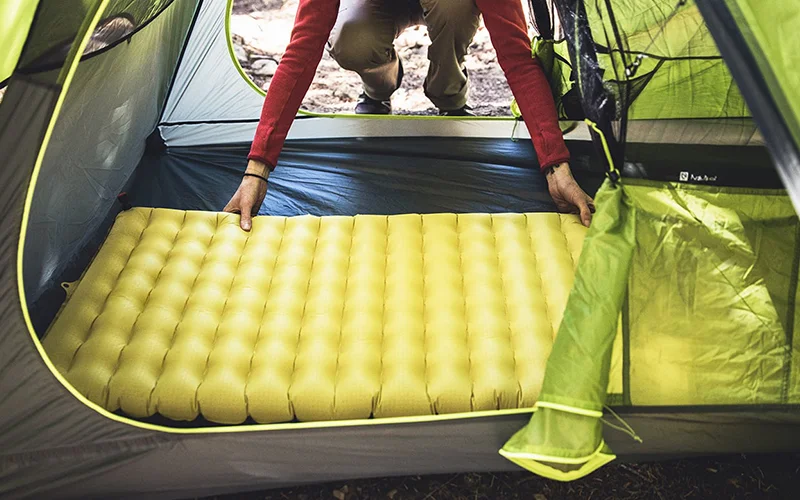
Sleeping Mats
Without a sleeping mat, you’ll probably feel the winter ground even with a very good sleeping bag.
The mat separates your sleeping bag from the floor, adding an extra layer of insulation. Just like sleeping bags, mats feature different temperature and performance ratings.
Get one that matches the rating of your sleeping bag and you’ll surely have a good night’s sleep.
The Fit
There are usually 5 different types of fit, though they may vary from one manufacturer to another. The five fits are expedition, valley, mountain, grand tourer, and alpine.
As the names suggest, these fits are for specific camping needs. If you want a sleeping bag with a good balance of weight and warmth, the alpine fit is a good choice.
On the other hand, the valley fit offers the most room and comfort. Some models are even spacious enough to fit a large pillow inside.
Sweet Dreams
The same guidelines apply for adult or children sleeping bags. For winter camping in general, it’s a good idea to aim for a lower temperature rating than needed. This ensures you get enough protection should the weather takes a turn for the worse.
At Tentworld, you won’t have any problems finding the right sleeping bags for your needs. You’ll find at our physical and online stores sleeping bags of different shapes, insulation materials, and temperature ratings.
Stop by any of our 15 locations to check out the complete offer.
